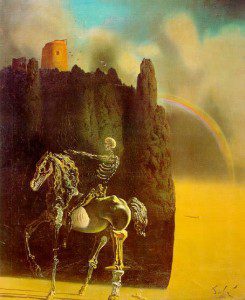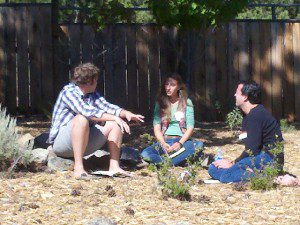
Milton demonized Death, suggesting that his other name is Satan. In our own times, we often make a true devil out of Death, by pretending that he does not exist. (Remember Baudelaire? “The Devil’s greatest art is to make us believe that he does not exist.”)
Yet Death hovers at your shoulder now, whether or not you will turn to look or listen to the murmurings at your ear. He bobs up like the specter in a medieval masque, shadowing your moves, edging your lines with irony.
Are you ready to meet me?
Why not? Right now, every cell in your body is constantly dying and being reborn. Who can count the little deaths that are taking place in your body as you inhale and exhale? Millions of cells are being born and devoured each time your lungs empty and fill. “What is there to fear?” as Michael Murphy’s character asks in Jacob Atabet. “Life and death are simultaneous. We are living flames, burning at the edge of this incredible joy.”
Death, by any name, is a peerless teacher.
In the Katha Upanishad, Death is Yama. The youth Nachiketas, cosigned to Death by his orthodox, disapproving father, enters the halls of Yama by an inner pathway whose gateway is the heart. When he arrives in this place, he at first encounters only utter darkness and emptiness, the experience of the Void. He waits three days and three nights before the bright flame of his spirit draws Death, who agrees to grant three requests. Nachiketas chooses wisely. He asks, first, that when he returns home, his father and his father;s people should know him and welcome him. Next, that he should have knowledge of the secret fire that leads to the heaven world of the immortals. Yama instructs him that this secret fire is “hidden in the cave of the heart.” Finally, Nachiketas wants to know what happens to those who “go beyond” — beyond not only physical death (it seems) but beyond the second death and further transformations. Yama does not want to answer this question, but the boy holds Death to his promise. The answer, again, lies in fire: the fire of the seeker’s own death and transformation. Nachiketas himself is the sacred flame. The journeyer himself is the path he must walk.
Edgar Cayce dreamed of Death as a fair, robust, rosy-cheeked young man who carried shears that he used to cut the psychic cord that binds the subtle body to the physical body at the crown of the head.
The close encounter with Death brings courage, which Rollo May rightly identified in The Courage to Create as the heart of the creative endeavor. It encourages the ability to go beyond the surface vicissitudes of daily life. It brings keen awareness of a larger reality.
When I most need clarity, I check in with my personal Death. He/she has worn many masks. When I was a teenager in Australia, she came swirling through my dreams and reveries in the terrible shapes of Kali. At the back of the history class on airless afternoons, I wrote a cycle of poems in her honor:
In the darkness, a dark woman came to me
Softly as the ticking of a clock
I have seen death swinging a Scottish broadsword. I have seen death as a great black bird, as a purple bruise flowering in an empty sky, as a sweet and luminous friend.
The Death I want now (to echo a splendid line of Octavio Paz) carries my name, wears my face.
–
Adapted from Dreamgates; Exploring the Worlds of Soul, Imagination and Life Beyond Death by Robert Moss. Published by New World Library.

